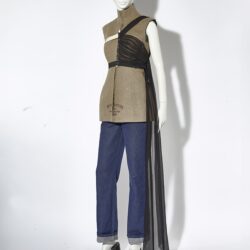Fashion from Antwerp: Influence & identity with Shayli Harrison

On the crossroads between psychedelic maximalism, VR tech and eco-punk futurism, you’ll find the designs of Antwerp Fashion Department alum Shayli Harrison. The Australian-born designer brings exuberant zest to every project she launches, building on a wealth of experience plus the creative buzz from her time at the Antwerp Academy. MoMu talked to Shayli Harrison about sparking creative energy through Antwerp’s nightlife, venturing out of the city to go work with Manish Arora in India and returning to set up a digital fashion company.

MoMu: What compelled you to stay in Antwerp after graduating in 2018? Did you apply for any internships?
Shayli Harrison: “Going back home didn’t make sense because I have established a network here, which is hugely valuable. There is so little work in fashion in Australia, and the type of fashion that gets created there is very different to everything I have learned here. I did apply for internships but for me as for many graduates, it's financially impossible to do unpaid internships and pay your way in London or Paris. I started applying for work, yet despite having prior experience, I didn't get anywhere with that. At a certain point, I felt like internships were literally the only way in. So, I landed a spot at Manish Arora, which was doable because India is an affordable place to live. I was in New Delhi for four months and then did Paris Fashion Week with Manish.”
What was your favourite part from that entire journey with Manish Arora?
I really liked the point where I finally got to show what I can do as they started preparing for Paris Fashion Week. We wanted to work with gender-diverse people within the LGBTQIA+ space and represent that spectrum.
"I have a lot of connections in that realm because I’m a camp club kid myself. Since I was 18, I have partied with my Australian club kid and drag friends, but I also have threads running through Antwerp, Berlin, Paris and London. That way, I ended up doing a lot of the casting, doing all the fittings and helped the incredible stylist Laurent Dombrowicz with the styling. I also got to design some accessories, which Björk ended up wearing on her tour.”
Then you came back to Antwerp. Did you have to reset a little bit?
“Yes, I had no idea what I was going to do next. I've been working for Joris Thoné Natuurtuin, who had helped me with my graduate exhibition. Joris has been building biotopes of different areas of Belgian nature on this amazing old farm property. So, I came back from Paris Fashion Week and I just started gardening. It was great to make that shift and work to restore biodiversity.”
What can you share about the current and upcoming work that you are preparing here in Antwerp?
“There are a lot of cool things going on right now for me. My head’s very deep into this digital fashion project I’m working on. I’m having fun doing lots of lighting and sound research, watching ‘The Matrix’ and Tarkovsky, learning about cinema and 3D technologies. So, I am now managing a collaborative team of ten people from all over the world and we are all contributing to a concept that I've created about plant-versus-human revenge. It’s centred around plant conservation and highlighting endangered Belgian native plant species, while anthropomorphizing them – because, unfortunately, we need to see ourselves in other things to feel empathy as humans. We've created all these 3D avatars wearing my digital fashion. They're going to be in a hellscape called the ‘Capitalocene’, a reflection on human capitalism in the future. It all adds up to a two-minute film that's showing on a platform founded by Evelyn Mora of Helsinki Fashion Week, called ‘Digital Village’. It’s a fashion metaverse: a space where you can buy, showcase and trade digital assets and exist as an avatar. My project is built in a game engine, so everything has the capacity to be used in a videogame or worn in-game in the future. It’s all very interesting, connecting fashion with gaming. You don't have to be tied to what we understand in reality, which is why I think it's worth doing because as designers we leave school with all these super creative ideas. But it ends there, a lot of the time. We can't continue because the work has artistic value, but no commercial value. In the gaming world however, the aesthetics are different.”
Virtual reality has been a part of your work since your time at the Antwerp Fashion Department.
“I've been playing around with 3D since 2015, when I scanned my fashion collections with Mark Florquin to create a virtual reality space to present to the teachers. That was the first time that anyone at the school tried this out. When I graduated, I was asked to do a commission work for Z33 gallery in Hasselt, where I created an experience inside a virtual reality space. I've been wanting to do that kind of thing again but build the narrative up a bit bigger.”
How do you envision your own future from your current projects on?
“It's still early days, but I have partnered with Ann Claes to launch a digital fashion agency called Mutani. I think 3D technology is difficult to understand for a lot of us who are used to painting, drawing, crafting and using our hands. So we are providing digitisation, promotion, marketing and sales services for designers and building a catalogue of the most radical looks for wearing in games and cyberspace. We are currently developing our test case, where we match designers with their aesthetic equal in digital development. It would just be a shame to have all these incredible artistic creations sitting in an archive, when they can be worn online and people can enjoy them infinitely.”
How could the city of Antwerp help you facilitate projects like that?
“There is already a lot of enthusiasm around the concept of Mutani and we are grateful for the support we have received from the City of Antwerp. At the moment, we are looking for more funding to build projects that prove our business model and provide exposure for the company and creators involved. The nicest thing about digital fashion is that it can be entered by anyone, designers don’t need to have a lot of resources. I know that there is a future in connecting fashion with games. And the cool thing about Antwerp is that it has an equally solid gaming and fashion community, but nobody knows each other yet.”










